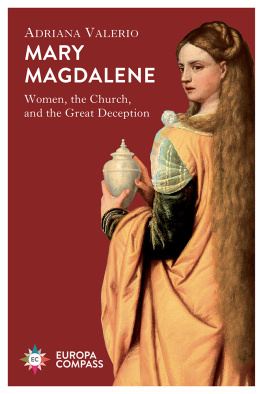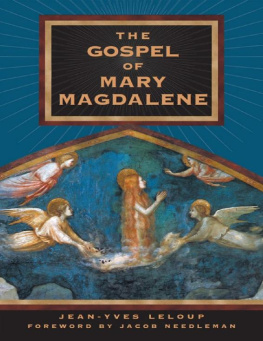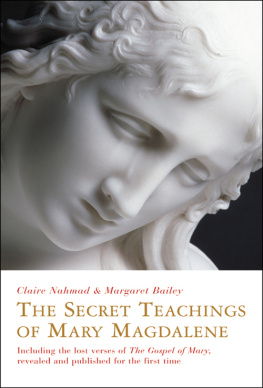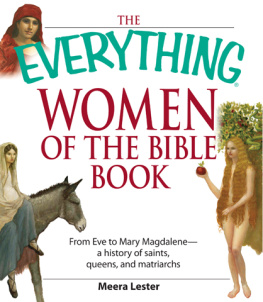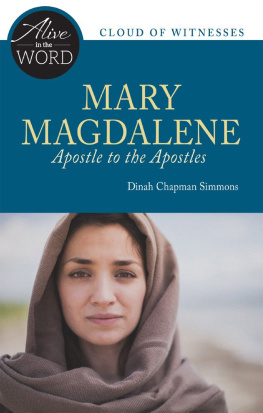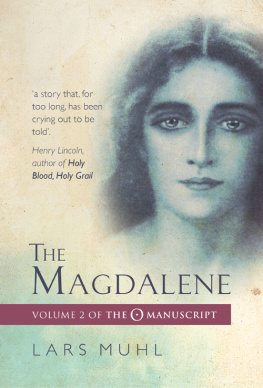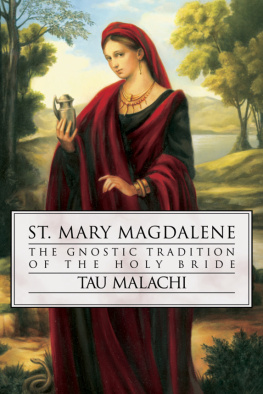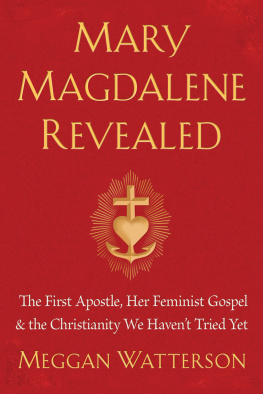MARY MAGDALENE
I NTRODUCTION
T HE BEGINNINGS OF A M ISUNDERSTANDING:
F ROM R EDEEMED P ROSTITUTE TO J ESUSS M ISTRESS
In one of his famous open sermons, the friar Bernardine of Siena preached the following in 1427: The Magdalene had offended the Creator in seven things. First, in seeking pleasure. Second, in lustful kissing and speaking by her mouth. Third, in the vanity of dressing her hair. Fourth, in looking lasciviously from her eyes. Fifth, in taking pride in walking and managing her entire body. Sixth, in the shameless exercise of licentiousness. Seventh, in her resolution and attempt to sin. She had triple inductive cause for these things, causes that give a very strong drive to sin. First, physical beauty. Second, an abundance of material riches. Third, relaxed control and freedom to do as she pleased. Indeed, she was beautiful, wealthy and lived without being subjected to anyone. And this is dangerous for women, more than all the things aforementioned. (Saint Bernardine of Siena, Sermon 46, translation from the Italian by Wendy Wheatley)
These clear words incontrovertibly reflect both the image created by theological tradition around the figure of the sinner Magdalene, and the male conviction that women should be subjugatednot free in their choices, and certainly not in charge of their own body, which is seen as the object and subject of licentiousness and temptation. As the monk Honorius of Autun portrayed her in the early 12th century, she was a common prostitute and of her own free will set up a brothel of sin and made it in truth a temple of demons, for seven devils entered into her and plagued her continually with foul desires. (Honorius of Autun, De Sancta Maria Magdalena)
Compounding this image are paintings of the Magdalene such as the one by Correggio, who presents her as seductive and dangerous, or the one by Titian, who portrays her as a penitent prostitute with curvaceous shapes and voluptuous beauty, or the one by Francesco Furini, who shows her as sensual and indecent.
After the mother of Jesus, Mary Magdalene is definitely the female biblical figure most often represented in literature and art. She is not only portrayed in a carnal and transgressive key, but also and at the same time, in her redemptive aspect. Her meeting Jesus led to conversion, the mortification of her body, and a life of seclusion. For many people, she is the one who led a life of sexual excess that she later repented. To them, she is an emblem of humanity enslaved to sin and therefore a forceful reminder of another woman, Eve, sometimes considered the progenitrix of the worlds evil. At the same time, however, the Magdalene is the prototype of the possibility of redemption. The image of the prostitute preserves the hope of salvation, so she can become the model of seductive eroticism who is pardoned to the extent that she transcends her own sensuality through a path of penitence and atonement.
Could there be a more powerful female archetype than that of the sinner who by contact with the Lord mended her ways, repudiated her body and tempting sexuality, and became a paradigm of mortification? Donatellos sculpture Penitent Magdalene (14531455) is emblematic in this regard.
Sermons, literature, iconography, music and todays movies continue to supply us overbearingly with the story of this woman marked by amorous passion and a sumptuous worldly life. She is presented to us much like a rich and elegant courtesan who renounces everything out of love for Christ, to whom she remains close throughout his entire life, all the way to the foot of the Cross.
A much more provocatory and complex argument has been postulated in recent years by a literary trend that presents the Magdalene as the partner or bride of Jesus, opening the thorny question of the Messiahs sexual life and the possibility of amorous involvement with his favorite disciple. See the director Martin Scorsese, who based his movie The Last Temptation of Christ (1988) on the homonymous 1951 novel by the Greek writer Nikos Kazantzakis. The film portrays Jesus as a man tormented on the Cross by the desire to experience a normal love story with the Magdalene, something he sees as a temptation to disavow for the good of humankind. Here too, while she is the object of nostalgic pleasure and the regret of not having experienced a life lived to the full, the woman is still seen as an enticement to resist in anticipation of a greater good: the salvation of humanity.
Much different is the outcome of the novel The Da Vinci Code (2003) by Dan Brown, where the author speculates that Mary Magdalene was Jesuss wife, a truth that the Church negated and hid in order to construct its power, exclude women and create a celibate, subjugated and easily manipulated clergy.
The questions I seek to explore in this book focus on the legitimacy of these more or less imaginative depictions. Just as there are no historical sources that testify to the Magdalene being Jesuss wife, the canonical gospels never say (despite the long, consolidated tradition to the contrary) that she was a sinner, a prostitute or a repentant for some other sin. What they do say is that she was a disciple and an apostle.
So how did this big misunderstanding come to be? It is a fallacious pretense that has weighed heavily on the collective consciousness regarding the female gender and on the role assigned to women in the Churches. It has for many centuries diminished the Magdalenes role as an apostle by transforming her into a reformed prostitute.
We will try to understand the birth of this error by entering into the folds of history, from the primitive Christian sources to their reception and interpretation, from literary documents to types of worship, and from artistic images to cinematographic portrayals. The scope of this research is not mere philological curiosity. The case of the Magdalene informs the very identity of Christianity because it poses crucial questions about the role of women in the Church, about the male monopoly over the theological and doctrinal patrimony, and about institutional bodies that have contributed historically to the marginalization of women. The revisiting of her memory is therefore an operation that we could describe as political, because it activates dynamics of change for the common good. This is usually called Church reform.
C HAPTER 1
W HO W AS THE M AGDALENE?
In the canonical gospels, female characters are often mentioned in a generic or anonymous manner, and not all of them are present or referred to in the same way. Mary Magdalene, however, is the only one to appear constantly in all the texts. This is a sign of her fame and authority within the group of the closest disciples who accompany Jesus from the very beginning of his mission.
Why the unusual name of Magdalene? In line with the patriarchal culture of the times, women were normally known for the man they belonged to, meaning they were his wife, daughter, mother or sister. But Mary Magdalene is not identified with a family role, thereby revealing the unusual position of a woman independent from her clan of provenance. Not being subjected to male authority enabled her to follow Jesus on his itinerant preaching, which tells us something extremely relevant about her personality, although we do not have sufficient elements to confirm or negate categorically whether she was a wife, a widow or a mother.
The mystery of her name
In the exegetical tradition that has taken hold over the centuries, the name Magdalene is considered to derive from her birthplace, the village of Magdala, possibly located on the western bank of Lake Tiberias in Galilee, not far from the fishing village of Capernaum, the area from which also the other disciples attracted to Jesuss preaching hailed. Yet the name does not appear in evangelical scriptures. At the time of the narrated events, there was a commercial fishing center that carried the Greek name of Tarichaea (salted fish), but had this been her native town, she would have been known as Mary from Tarichaea or the Tarichaean.

